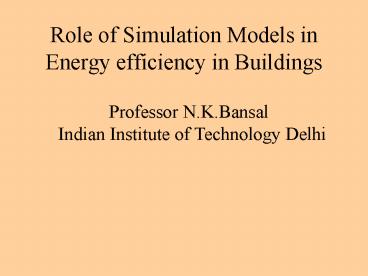Role of Simulation Models in Energy efficiency in Buildings PowerPoint PPT Presentation
1 / 34
Title: Role of Simulation Models in Energy efficiency in Buildings
1
Role of Simulation Models in Energy efficiency in
Buildings
Professor N.K.Bansal Indian Institute
of Technology Delhi
2
Windows
- Complex and most interesting elements of a
building - Provide light and fresh air as well as the view
- Result in major heat gain in summer and losses in
winter
3
Traditional Buildings
- Buildings were designed by taking advantage of
sunlight,wind,earth,vegetation and ventilation - Windows were provided with shades to protect from
summer Sun and cold drafts in winter
4
Historical Developments
- 1959-70 Availability of cheap energy led to
building design that were not climate sensitive - 1970s The energy costs increase rapidly leading
to insurgence of traditional ideas - Windows were necessary for light and winter heat
5
1970s onwards
- Emphasis on efficient building elements and
mechanical systems - Windows have gone a technical revolution
6
Developments in Germany for Energy Efficiency in
Buildings
7
(No Transcript)
8
Energy Performance of Windows
9
Technology Improvements
- Glazing Unit StructureMultiple layer of glass or
plastic films and reduce energy losses attributed
to convection between window layers to improve
thermal resistance
10
Technology Improvements
- Low Emittance Coatings Have good solar
transmittivity but high reflectance(low
emittance) to long wave radiation. Reduction in
heat transfer by 5 to 10 times possible - Low Conductance Gas Fills Argon, Krypton have
lesser thermal conductivity than air
11
- Technology Improvements
- Warm Metal SpacersMetal spacers used to separate
glazing layers can increase heat losses and can
cause condensation. New materials are being used
as spacers - Thermally Insulated Sash and Frames New
Materials like PVC frames - Solar Control Coatings Reduce heat but no light
- Improved weather stripping Better weather strips
to reduce leakages
12
Cooling Energy Demand in US Climates
13
Energy consumption in the commercial and
residential buildings in India
Residential buildings 116 billion units
Commercial buildings 33billion units
14
Load contribution through various building
components
A study was done for a conditioned typical Indian
building of 10 sq. m. floor area with overall U
value of walls as 1.819 W/m2-K, roof 1.979
W/m2-K, floor 0.822 W/m2-K, and window as 6.43
W/m2-K with one air change in hot dry climate
with 10 window area
The peak load contribution of single glazed
window is around 22 whereas the total
contribution of walls roof underground
surface 40
15
Simulation is to assume the likeness of a system
16
Schematic of a Window Assembly
17
(No Transcript)
18
Experimental Simulation
19
External and Internal Surface Heat Transfer
Coefficient
20
U value of Window unit obtained experimentally
21
The U value of Window unit obtained through
simulation
22
Climatic Zones in India
23
Annual Climatic Variation in Six Climatic Zones
of India
24
External (ho) and Internal (hi) heat transfer
coefficients for the six climatic zones of India
(for 3 mm single glazed clear window) at 1.00
meter above the plinth level.
25
Comparison of general features and capabilities
of available softwares
26
EnergyPlus 1.0 EnergyPlus is based on the
most popular features and capabilities of BLAST
and DOE-2 but is a completely new program written
in Fortran 90. New features include input and
output data structures tailored to facilitate
third party module and interface development.
DOE 2.1E Calculation of heating / cooling
energy demand
Hourly Climatic Data
EnergyPlus 1.0 Calculation of artificial
lighting demand
4 Design days per annum
27
Various Window Sections used for Simulations
Glazing Material 3mm clear glass. Gap Between
Glazing Layers 12.7 mm. (ASHRAE) Gas Air Frame
Material Wood, Vinyl Glass Emis 0.840 Visible
Transmittance 0.82 Spectrally Selective Coating
- Nil
Glazing Material 3mm clear glass. Gap Between
Glazing Layers 12.7 mm. (ASHRAE) Gas
Argon Frame Material Wood, Vinyl Glass Emis
0.840 Visible Transmittance 0.77 Spectrally
Selective Coating Outer side of inner Glazing
(Simla Leh) - Inner Side of outer
Glazing (Jodhpur, Mumbai, Delhi)
Glazing Material 3mm clear glass. Gap Between
Glazing Layers 12.7 mm. (ASHRAE) Gas Air Frame
Material Wood, Vinyl Glass Emis 0.840 Visible
Transmittance 0.75 Spectrally Selective Coating
- Nil
28
Optimized window area for PVC double glazed
window in Different Indian Climates and for
Different orientations
29
Minimum Total Energy Demand and the corresponding
percentage Window Area for different orientations
and climatic conditions in India
Sp. Energy in kwh/sqm.a Results obtained for
PVC double glazed window
30
Comparison of Total Energy Demand (Hot Dry
Climate)Double Glazed Window
31
Comparison of Total Energy Demand (Composite
Climate)Double Glazed Window
32
Comparison of Total Energy Demand (Cold Sunny
Climate)Double Glazed Window
33
Main Results of Window Simulation
- From total energy point of view, no optimization
is possible for non-insulated buildings with
single glazed windows. - For double glazed, double-glazed low-E and triple
glazed windows in an insulated building with
overall U value less than 0.6 W/m2K., the
optimization is possible for which values can be
obtained using simulation models. - In moderate climatic conditions Lighting
contributes a major portion of total demand. - Double Glazed Window Good for Hot, Warm
Composite Climates - Advanced Windows (Double Low-E Triple) Able
to reduce energy demand by 20 in cold conditions
34
Conclusions
- The cooling/heating energy consumption can be
reduced considerably by using efficient building
elements of which windows are very important - Simulation models help to estimate the reduction
in energy consumption - Simulation models help to quantify the properties
of building elements - Need to be adopted for Local Conditions

